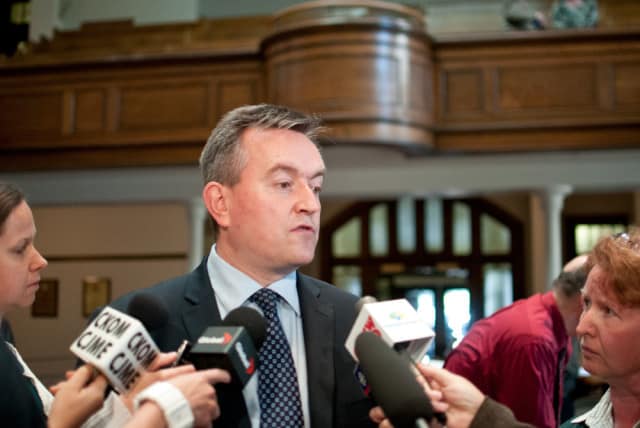
A media scrum with Martin Phillipson, vice-provost College of Medicine organizational restructuring.
The aisles of Convocation Hall were packed tight as the general academic assembly convened for a rare special meeting Sept. 6 and voted to force university council to revisit its decision to approve sweeping changes to the College of Medicine.
The GAA, made up of more than 1,000 full-time faculty members from across campus, voted with a slim two-thirds majority in favour of the college’s faculty, who have been the driving force behind the lobbying efforts to have council reconsider its May decision.
“We are extremely pleased,” veterinary medicine professor Claire Card said. “We are feeling like the democratic voice of the collegiate was heard and that people understand the issues.”
Council approved a motion at its May 17 meeting for the creation of three new divisions of governance within the college, despite opposition from 87 per cent of the medical school’s faculty. Now council must rehash the plan at its next meeting Sept. 20, where a two-thirds majority is needed to reaffirm the restructuring plan.
University provost and vice-president Brett Fairbairn, along with former dean of the college William Albritton, drafted the plan after a team of inspectors visited the college and found 10 areas of weakness. In a letter sent to Albritton last year, accreditors wrote that if the non-compliance areas were not corrected soon, the college would risk being placed on probation and “seriously compromise the ability of the faculty to deliver a quality medical education program.”
The team of inspectors are expected back at the U of S to check the college’s progress by early 2013.
Fairbairn told the assembly that the accrediting bodies found “deep-rooted” issues with the structure of teaching duties within the undergraduate program. He said the problem has been “years and years in the making” and that the “college is not able to fix itself.”
“The clock is ticking to finish the work,” he said. “The college does not have another ten years — in fact, it does not have another ten months.”
Fairbairn said the current structure of the college is unique amongst other Canadian medical schools and does not prioritize academic matters or incentivize research. He said the three-division model — biomedical and population sciences, clinical research and teaching — corresponds to what exists elsewhere and will provide accountability for teaching and research.
The college falls well short of many of its national counterparts in bringing home federal research dollars.
Tom Wilson, chair of the college’s faculty council, said the process of restructuring has been administered too fast. He said the faculty was not adequately consulted before the plan was brought forward.
“The plan was developed by three people, working essentially in secret,” he said. “Council was not apprised of the risks of passing the motion.”
Albritton, the former dean and an original architect of the plan, spoke in favour of sending the decision back to council, resulting in a roaring applause from his former colleagues. He said going forward despite angered opposition from faculty “is simply wrong for a collegial institution.”
“Doctor Albritton’s statement was one of the most courageous public statements that I’ve seen in the 15 years I have been at the university,” medical school faculty member Marcel D’Eon said.
Wilson and the faculty were optimistic following the Sept. 6 vote.
“Our general approach will be one of cooperation, negotiation, rather than confrontation,” he said. “The College of medicine does want to change, we just don’t want this particular structure that was handed to us.”
Wilson said faculty and administration can work together to come up with a better plan than the three-division model, but could not describe to reporters what that would potentially look like.
Vice-Provost Martin Phillipson, whose portfolio includes the College of Medicine organizational restructuring, was disappointed but not surprised by the decision. He said the university will continue moving forward on improving the “essential pillars of the medical school.”
“The reform process will keep going, the groups that I am on, we will continue to work on accreditation issues, we will work on relationships with the health regions, we will work on a new funding model for physicians. That work will continue,” Phillipson said. “What council has been asked to reconsider is the divisional structure.”
He said the current structure over-values clinical service to the detriment of teaching and research.
“The university will not stop until we’ve secured a structure that will deliver on all three of those missions,” Phillipson said. “My firm belief is that council made the right decision in May and when we go back to reconsider it on Sept. 20, I believe that council will support us.”
—
Photo: Raise Pezderic/The Sheaf